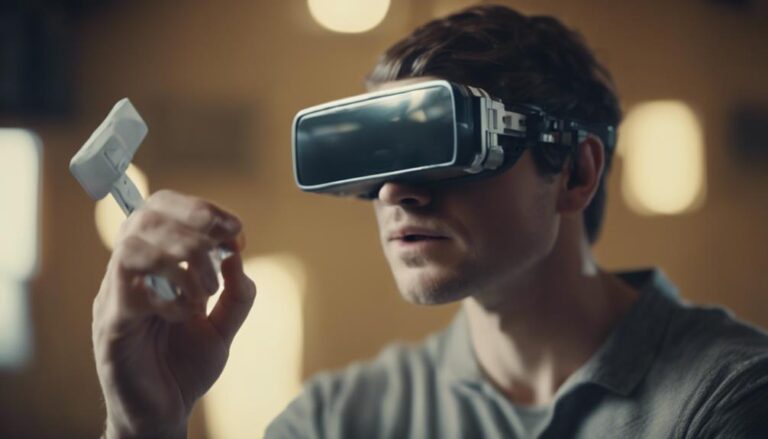The Future of Remote Work Technology: Predictions and Trends
As you navigate the world of remote work technology, consider this: the horizon is teeming with possibilities, poised to reshape the way we work and collaborate. From augmented reality's potential to revolutionize virtual interactions to the intricate dance between cybersecurity and innovation, the future holds a tapestry of transformative trends waiting to be unraveled. Stay tuned as we unravel the intricate threads weaving together a future where connectivity, productivity, and engagement converge in the dynamic landscape of remote work technology.
Key Takeaways
- Augmented Reality (AR) integration enhances remote collaboration and training experiences.
- Cybersecurity enhancements ensure data protection in remote work environments.
- AI-powered productivity solutions optimize task management and virtual assistant integration.
- Hybrid workspace models combine remote flexibility with in-person interactions for enhanced productivity.
- IoT impacts remote work by improving connectivity, communication, and operational efficiency.
Remote Work Tools Evolution
As remote work continues to revolutionize the traditional office environment, the evolution of remote work tools has been rapid and dynamic. Remote communication has become more seamless and efficient than ever before, enabling teams to collaborate across vast distances effortlessly.
Virtual meetings have transcended the limitations of physical boardrooms, offering a platform where face-to-face interactions are now possible regardless of geographical locations.
Innovations in remote work tools haven't only focused on enhancing communication but also on creating immersive virtual meeting experiences. With the integration of advanced video conferencing technology, virtual meetings now simulate in-person interactions with features like real-time collaboration on documents and virtual whiteboards.
These tools have shifted the paradigm of remote work, making it feel more interconnected and interactive than previously imagined.
Looking ahead, the evolution of remote work tools is poised to continue on an upward trajectory, with a strong emphasis on improving user experiences and fostering deeper connections in virtual workspaces. The future promises a landscape where remote communication and virtual meetings seamlessly blend to create a cohesive and engaging remote work environment.
Augmented Reality Integration
Imagine a work environment where teams collaborate seamlessly through Augmented Reality, visualizing projects in real-time regardless of physical distance.
Picture immersive training sessions where employees learn complex tasks through interactive AR simulations, boosting both efficiency and engagement.
Envision everyday workplace applications enhanced by AR technology, revolutionizing how tasks are completed and information is shared in a remote setting.
AR in Collaboration
Incorporating augmented reality into collaborative work environments revolutionizes how teams interact and engage, enhancing productivity and creativity.
AR for communication in remote work technology advancements is reshaping the way teams collaborate, especially in remote meetings. Through AR integration, team members can access new opportunities despite physical distances, as if they're working side by side in a shared virtual space.
Visualizing projects, sharing ideas, and providing real-time feedback become more immersive and interactive experiences, fostering better understanding and idea generation. This technology not only enhances the efficiency of remote meetings but also sets a trend for the future workplace, where virtual collaboration is seamless and engaging.
By leveraging AR in collaborative settings, companies can discover new possibilities for teamwork, creativity, and innovation, creating a dynamic work environment that transcends traditional boundaries.
As AR continues to evolve, its potential to revolutionize collaboration in remote work environments is limitless.
AR for Training
Utilizing augmented reality for training purposes in remote work settings offers a transformative approach to skill development and knowledge acquisition. Interactive simulations powered by AR technology provide employees with hands-on experience in a virtual environment, enabling them to practice tasks and scenarios as if they were physically present.
This immersive learning method enhances engagement and retention rates by allowing individuals to learn by doing, rather than passively consuming information.
AR Workplace Applications
Augmented reality integration within the workplace is revolutionizing how employees interact with their environment, enhancing productivity and efficiency through immersive digital experiences. Remote collaboration has been greatly enhanced through AR workplace applications, allowing team members from different locations to work together seamlessly as if they were in the same physical space. This technology enables real-time interactions, virtual meetings, and shared workspaces that bridge the gap between remote colleagues, fostering a sense of togetherness and teamwork.
Moreover, AR training within the workplace has seen significant advancements, providing employees with hands-on learning experiences in a digital environment. This innovative approach to training allows for interactive simulations, on-the-job practice, and instant feedback, leading to faster skill acquisition and improved retention rates.
Cybersecurity Enhancements
Enhancing cybersecurity measures is crucial for the future of remote work technology to guarantee data protection and privacy. As remote work becomes more prevalent, ensuring the security of sensitive information is essential.
Implementing robust data encryption protocols is necessary to safeguarding data as it travels between remote devices and servers. By encrypting data, you can prevent unauthorized access and protect the confidentiality of your communications and files.
In addition to data encryption, effective access control mechanisms play a significant role in enhancing cybersecurity for remote work environments. By carefully managing user permissions and authentication processes, organizations can limit access to sensitive data and systems only to authorized personnel. Multi-factor authentication, biometric identification, and role-based access controls are some of the strategies that can be employed to bolster security measures and prevent potential breaches.
AI-Powered Productivity Solutions
Imagine a future where AI seamlessly integrates into your daily workflow, enhancing task management and providing virtual assistant support.
These AI-powered productivity solutions have the potential to revolutionize how you work remotely, streamlining processes and boosting efficiency.
With advancements in artificial intelligence, the possibilities for optimizing productivity in the remote work landscape are endless.
AI in Task Management
Embrace the future of remote work technology with AI-powered productivity solutions revolutionizing task management efficiency. Machine learning algorithms are at the forefront of this revolution, enabling project automation and streamlining workflows like never before. By harnessing the power of AI in task management, you can expect a significant reduction in manual labor, increased accuracy in project planning, and improved overall productivity.
AI-driven task management tools are designed to analyze data patterns, predict potential roadblocks, and suggest best task allocation strategies. Through sophisticated algorithms, these tools can adapt to your work habits, learn from your preferences, and proactively assist in organizing your tasks more effectively.
With AI in task management, you can automate repetitive tasks, prioritize assignments based on deadlines and importance, and allocate resources efficiently. By integrating machine learning capabilities into your daily workflow, you'll experience enhanced decision-making support, improved time management, and a smoother overall work process.
Embrace the future of AI in task management to elevate your productivity to new heights.
Virtual Assistant Integration
In the ever-evolving landscape of remote work technology, the integration of virtual assistants powered by AI is reshaping the way tasks are managed and productivity is optimized.
Imagine a future where you can effortlessly navigate your workday using simple voice commands to delegate tasks, schedule meetings, and gather information. Virtual assistants are becoming more intuitive and proactive, learning your work patterns and preferences to provide tailored assistance.
With the rise of virtual meetings as a staple in remote collaboration, virtual assistant integration offers a seamless experience.
Envision this: you simply instruct your virtual assistant to set up a virtual meeting, invite participants, and even generate meeting agendas based on past interactions and ongoing projects. This level of automation not only saves time but also enhances the overall efficiency of virtual meetings.
As virtual assistants continue to evolve, their integration into the remote work environment holds immense potential for streamlining workflows, increasing productivity, and improving the overall remote work experience.
Embrace this transformative technology to access new levels of efficiency and effectiveness in your remote work routine.
Hybrid Workspace Models
Hybrid workspace models are revolutionizing the way organizations structure their work environments, blending the flexibility of remote work with the collaboration of in-person interactions. This dynamic approach allows employees to enjoy flexible schedules while still benefiting from the synergy that face-to-face communication brings.
Office integration in these models is vital, as it guarantees that physical workspaces are optimized for both individual tasks and team projects. Remote collaboration plays a pivotal role in hybrid workspace models, enabling seamless communication and cooperation among dispersed team members.
The design of these workspaces is strategic, focusing on creating areas that foster creativity, innovation, and productivity. By incorporating elements that cater to both remote and in-person work styles, organizations can maximize the potential of their teams and create a harmonious balance between autonomy and teamwork.
In this evolving landscape, the hybrid workspace represents a forward-thinking approach that prioritizes the well-being and efficiency of employees while embracing the benefits of technological advancements.
IoT Impact on Remote Work
The integration of Internet of Things (IoT) technology is reshaping the landscape of remote work, enhancing connectivity and efficiency in unprecedented ways. Smart devices play a pivotal role in this transformation, allowing seamless communication and interaction between employees regardless of their physical locations. These devices, ranging from smart thermostats to intelligent virtual assistants, streamline processes and enhance productivity in remote work settings.
Remote monitoring is another key aspect where IoT is making a significant impact. Through IoT-enabled sensors and devices, employers can track the performance and well-being of remote workers in real-time. This not only guarantees that tasks are being completed efficiently but also allows for immediate intervention if any issues arise. Remote monitoring through IoT technology provides valuable insights into work patterns, helping companies optimize workflows and improve overall productivity.
As IoT continues to evolve, its influence on remote work is expected to deepen, revolutionizing how individuals collaborate, communicate, and operate in virtual work environments. Embracing these advancements can lead to a more connected, efficient, and dynamic remote work landscape.
Remote Training Innovations
Remote training innovations are revolutionizing how organizations equip their remote workforce with essential skills and knowledge. Through virtual simulations and interactive learning platforms, employees can now engage in immersive training experiences from anywhere in the world. These technologies enable individuals to practice real-life scenarios in a safe environment, fostering practical skills and boosting confidence.
Moreover, remote coaching has become increasingly personalized, with tailored feedback mechanisms that cater to individual learning styles and needs. This one-on-one guidance helps employees develop their strengths, address weaknesses, and progress at their own pace.
The era of standardized training programs is evolving into a more dynamic and adaptive model, where each employee receives a unique learning journey.
Virtual Team Building Strategies
Amid the shift towards decentralized work environments, fostering team cohesion and collaboration through virtual team building strategies has emerged as a pivotal aspect of organizational success. Online icebreakers play an essential role in bridging the physical distance between team members, setting a positive tone for interactions. These icebreakers can range from fun quizzes to virtual scavenger hunts, encouraging engagement and communication.
Team bonding activities, such as virtual coffee breaks or shared virtual lunches, help create a sense of camaraderie among remote team members, enhancing trust and collaboration.
Virtual team challenges present exciting opportunities for teams to work together towards a common goal, fostering problem-solving skills and teamwork. Remote team games, like virtual escape rooms or collaborative online puzzles, not only promote friendly competition but also strengthen the bond among team members.
Conclusion
As you embrace the future of remote work technology, envision a world where connectivity weaves a tapestry of efficiency.
Where cybersecurity fortresses protect your digital domain, and where AI-powered solutions elevate productivity to new heights.
With hybrid workspaces as your canvas, IoT as your brush, and virtual team building as your palette, paint a picture of remote work that isn't just remote, but truly interconnected, immersive, and engaging.







